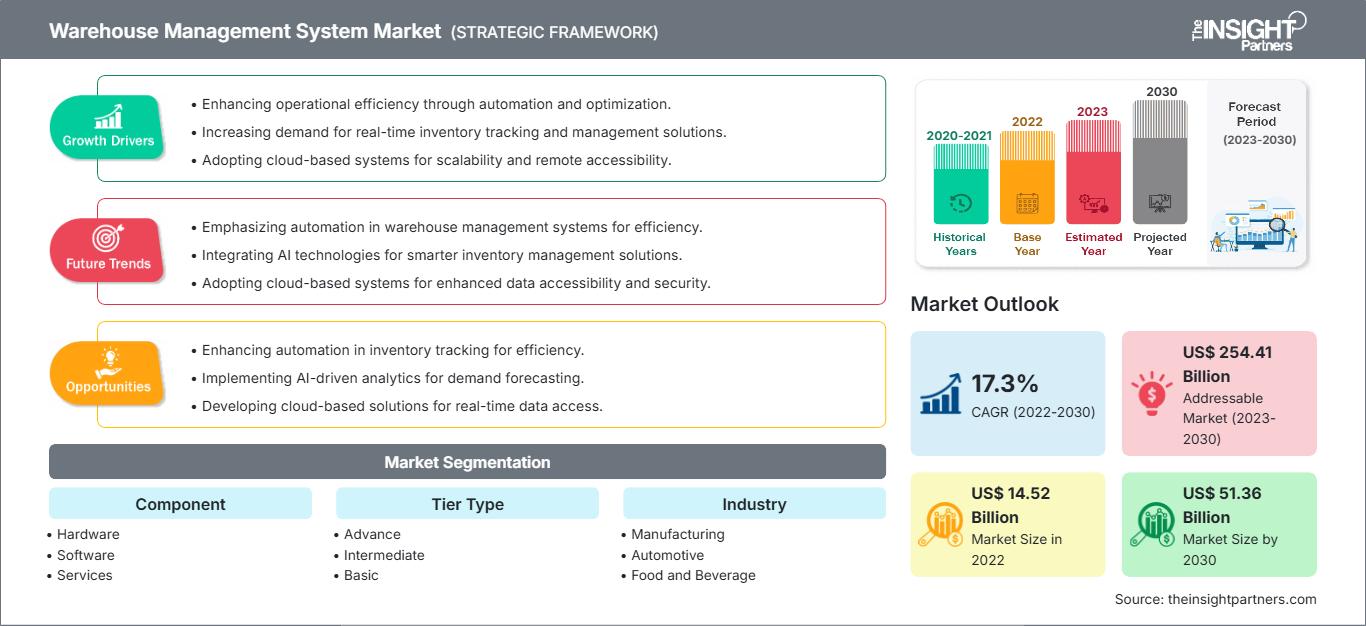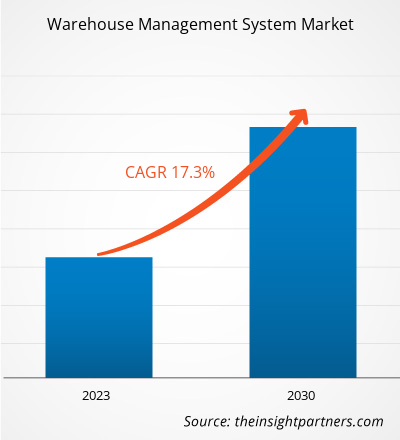倉庫管理システム市場は、2022年の145億1,707万米ドルから2030年には513億6,023万米ドルに成長すると予想されており、2023年から2030年にかけて17.3%のCAGRを記録すると推定されています。
多くの企業は、特にCOVID-19パンデミックの発生後、在庫管理を改善するためにロボット技術を導入しています。ロボット技術の実装により、人件費が削減され、より効率的で正確なプロセスフローが提供され、ロボットは同じコストで24時間365日稼働できます。さらに、人工知能(AI)とモノのインターネット(IoT)と統合されたロボット技術は、企業が倉庫の自動化を改善するのに役立ちました。ロボット技術と倉庫管理システムの統合により、ロボットに在庫データが提供され、正確で効率的な倉庫業務を実行するのに役立ちます。このようなメリットが、倉庫管理システム市場の成長を牽引しています。
倉庫では、特に製造業、小売業、eコマースなどの業界で、単純で反復的な作業を行うロボットを導入しています。COVID-19パンデミックによる消費者の嗜好の変化を受け、あらゆる規模の倉庫では、ソーシャルディスタンスを維持し、施設で働くスタッフ数を削減するために、自動化の導入が進んでいます。さらに、ロボットは、体温測定や手指消毒剤の投与など、従業員に代わって作業を行うために広く活用されています。多くの物流専門家も、手作業から自動化へと移行しています。倉庫ロボット技術は急速に進歩しており、例えば、ロボットは倉庫内を自律的に移動できます。商品の大量輸送に加えて、ロボットはピッキング、梱包、パレット積み込みも行うことができるため、倉庫関連のプロセスを簡素化できます。さらに、eコマースの人気の高まりにより、WMS全体でロボットの需要が加速しています。オンライン注文の増加と迅速な配送の需要の高まりを受け、倉庫やフルフィルメントセンターは、注文処理の改善と在庫管理の改善のためにロボットシステムを活用しています。ロボットハードウェアシステムの需要は高まっており、倉庫内での商品の取り出しや運搬にかかる時間とリソースを削減するのに役立ちます。このシステムにより、作業員は梱包や出荷といったより複雑なプロセスに集中できるようになります。
要件に合わせてレポートをカスタマイズ
レポートの一部、国レベルの分析、Excelデータパックなどを含め、スタートアップ&大学向けに特別オファーや割引もご利用いただけます(無償)
倉庫管理システム市場: 戦略的洞察

- このレポートの主要な市場動向を入手してください。この無料サンプルには、市場動向から見積もりや予測に至るまでのデータ分析が含まれます。
レポートの一部、国レベルの分析、Excelデータパックなどを含め、スタートアップ&大学向けに特別オファーや割引もご利用いただけます(無償)
倉庫管理システム市場: 戦略的洞察

- このレポートの主要な市場動向を入手してください。この無料サンプルには、市場動向から見積もりや予測に至るまでのデータ分析が含まれます。
倉庫管理システム市場 -
COVID-19パンデミックによるヨーロッパの倉庫管理システム市場の成長への影響
ヨーロッパでは、COVID-19パンデミックに対する各国の対応のタイミングと程度、そしてそれに続く経済の段階的な再開が、この地域の倉庫管理システム市場に悪影響を及ぼしました。 著名なヨーロッパの倉庫管理システム市場のプレーヤーは、輸出入制限によりサプライチェーンが混乱したため、収益予測の大幅な下降に見舞われました。 さらに、特にパンデミックの初期段階における商業スペースでの製造と生産の停止は、この地域の市場に悪影響を及ぼしました。 消費者が急速にインターネットプラットフォームに移行するにつれて、製造、小売、eコマース、自動車など、いくつかの垂直分野でWMS製品が採用されています。さらに、オンラインでの食品や飲料、必需品、処方箋の需要が高まり、倉庫の必要性が高まっています。
WMSソリューションの需要の高まりに対応するため、大手企業が複数の国に倉庫を開設しています。その結果、WMSはeコマース企業やサードパーティロジスティクス企業でますます普及しています。Amazon、Asos、eBayなどのeコマース大手は、この地域全体に新しい施設を設立するため、WMSの需要を継続的に牽引すると予測されています。さらに、この地域でのCOVID-19症例の減少により状況は改善しており、市場は加速し、予測期間を通じて拡大するでしょう。したがって、倉庫管理システム市場の成長は、COVID-19後に大幅に増加すると予測されています。
市場洞察 - 倉庫管理システム市場
進化するグローバルサプライチェーンネットワーク
サプライチェーンネットワークにおける因果関係は比較的単純です。組織の倉庫ネットワークは地理的に分散しているため、管理の複雑さが増しています。国境を越えたサプライチェーン管理には、異なる国のユーザーが同じ基盤システムを使用して業務を遂行するため、規制やローカリゼーションの複雑さにも対処する必要があります。さらに、WMSは、グローバル化によって増大する物流負担への対応において、組織を支援する上で重要な役割を果たします。優れたWMSソリューションは、専用のデータ収集および統合ツールを通じて、この負担をさらに高めることができます。2023年1月、Crave InfoTechはSAP BTPをベースに構築された拡張倉庫管理(EWM)の新製品「cEWM」を発表しました。これは、オンラインでもオフラインでも倉庫プロセスを合理化するクロスプラットフォームです。倉庫で使用されている従来のインターネット移植型アプリは、接続が失われることが多く、それに伴いすべてのプロセスデータが失われ、サプライチェーン全体のボトルネックとなっていました。Crave InfoTechのcEWMアプリはこれらの課題に対処し、プロセスの途中で切断されても、オフラインでもオンラインでも効率的に動作します。さらに、サプライ チェーン管理は、原材料の収集から製造、最終製品の配送まで、途切れることのない商品の流れを維持することを目的としています。
コンポーネントベースの洞察 - 倉庫管理システム市場
コンポーネントに基づいて、倉庫管理システムの市場規模は、ハードウェア、ソフトウェア、およびサービスに分類されます。ハードウェア セグメントは、2022 年に市場で最大のシェアを占めました。
WMS のハードウェア コンポーネントは、タスクと材料の特性に基づいて床面積の最適な使用方法を分析することにより、倉庫のワークフローを最適化します。倉庫は、製品や材料、または機器を保管するのに最適な場所を検討することにより、運用コストを削減できます。ハードウェア システムを実装すると、在庫の検索、タスクのインターリーブ、ウェーブ プランニング、注文の割り当て、在庫管理、サイクル カウント、ピッキング、補充、梱包、出荷、労務管理、自動資材搬送装置 (MHE) インターフェースなどのコア機能が有効になります。 COVID-19パンデミックの発生により、自動化への進展が加速し、失業率が急上昇したにもかかわらず、顧客の需要の高まりに対応するため、倉庫業務は自動化されました。
倉庫管理システム市場は、コンポーネント、階層タイプ、業界、および地域に基づいて分割されています。コンポーネントに基づいて、市場はハードウェア、ソフトウェア、およびサービスに分類されます。階層タイプに基づいて、市場は高度(階層1)、中級(階層2)、および基本(階層3)に分類されます。業界に基づいて、倉庫管理システム市場は製造、自動車、食品および飲料、電気および電子、ヘルスケア、小売およびeコマース、その他に分類されています。
地理に基づいて、倉庫管理システム市場規模は、主に北米、ヨーロッパ、アジア太平洋(APAC)、中東およびアフリカ(MEA)、および南米に分割されています。2022年には、APACが最大の倉庫管理システム市場シェアを占め、予測期間中もその優位性を維持すると予想されます。この地域は、予測期間中に世界の倉庫管理システム市場において最高の CAGR を記録することも予想されています。
International Business Machines Corp、SAP SE、Epicor Software Corp、Softeon Inc、Oracle Corp、Panasonic Holdings Corp、Infor Inc、Manhattan Associates Inc、PTC Inc、および Tecsys Inc は、主要な倉庫管理システム市場プレーヤーです。
倉庫管理システム市場の地域別分析
予測期間を通じて倉庫管理システム市場に影響を与える地域的な傾向と要因は、The Insight Partnersのアナリストによって徹底的に説明されています。このセクションでは、北米、ヨーロッパ、アジア太平洋、中東・アフリカ、中南米における倉庫管理システム市場のセグメントと地域についても説明します。
倉庫管理システム市場レポートの範囲
| レポート属性 | 詳細 |
|---|---|
| の市場規模 2022 | US$ 14.52 Billion |
| 市場規模別 2030 | US$ 51.36 Billion |
| 世界的なCAGR (2022 - 2030) | 17.3% |
| 過去データ | 2020-2021 |
| 予測期間 | 2023-2030 |
| 対象セグメント |
By コンポーネント
|
| 対象地域と国 | 北米
|
| 市場リーダーと主要企業の概要 |
|
倉庫管理システム市場のプレーヤー密度:ビジネスダイナミクスへの影響を理解する
倉庫管理システム市場は、消費者の嗜好の変化、技術の進歩、製品メリットへの認知度の向上といった要因によるエンドユーザーの需要増加に牽引され、急速に成長しています。需要の増加に伴い、企業は提供内容の拡充、消費者ニーズへの対応のための革新、そして新たなトレンドの活用を進めており、これが市場の成長をさらに加速させています。

- 入手 倉庫管理システム市場 主要プレーヤーの概要
倉庫管理システム市場のプレーヤーは、高度で効率的なシステムの開発に重点を置いています。例:
- 2023年、Tecsysは、倉庫内eコマースフルフィルメントソリューションにより、小売業者やブランドが既存の卸売・流通モデルやレガシーシステムをそのままに、eコマースフルフィルメントを完璧に実行できるようになると発表しました。
- 2022年、業界クラウド企業のInforは、大手国際製薬企業向けにサードパーティロジスティクスの保管・流通プロバイダーであるMoonehがInfor WMS(倉庫管理システム)を導入したことを発表しました。効率的で効果的な倉庫運営を確立することに加えて、このソリューションは完全な在庫追跡を提供します。大手サプライチェーンコンサルティングおよびソフトウェア実装プロバイダーであるSNSが、このプロジェクトを成功裏に遂行しました。
- 過去2年間の分析、基準年、CAGRによる予測(7年間)
- PEST分析とSWOT分析
- 市場規模価値/数量 - 世界、地域、国
- 業界と競争環境
- Excel データセット
最新レポート
関連レポート
お客様の声
購入理由
- 情報に基づいた意思決定
- 市場動向の理解
- 競合分析
- 顧客インサイト
- 市場予測
- リスク軽減
- 戦略計画
- 投資の正当性
- 新興市場の特定
- マーケティング戦略の強化
- 業務効率の向上
- 規制動向への対応




















 無料サンプルを入手 - 倉庫管理システム市場
無料サンプルを入手 - 倉庫管理システム市場